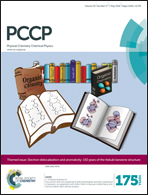Structural and electronic properties of the heterointerfaces for Cu2ZnSnS4 photovoltaic cells: a density-functional theory study†
Abstract
The quaternary compound semiconductor Cu2ZnSnS4 (CZTS) is a promising photovoltaic absorber material for thin-film solar cell applications. Density-functional theory calculations have been performed to investigate the structural and electronic properties of the CdS/CZTS heterointerfaces in CZTS-based cells. We find that CdS favors epitaxial growth on the Cu–Zn plane of CZTS along the direction of [100], which can eliminate the effects of the wrong bonds at the interfaces and enhance the energetic barrier for charge carrier recombination across the interfaces with an increased band gap. The band alignment is calculated for the epitaxial CZTS/CdS heterointerface by employing the HSE06 functional and the results show a type-II band alignment with VBO and CBO values of 0.95 eV and −0.05 eV, respectively. Also, the experimental phenomenon of Zn segregation at CdS/CZTS interfaces is corroborated. Zn segregation can enhance the stability of the heterointerfaces, but damage the solar cell performance by decreasing the band gap when the Zn concentration is sufficiently high. We show that besides the defects and undesired phases in CZTS, the heterointerfaces between the absorption layers (CZTS) and the buffer layer (CdS) can also be an important factor that affects the performance of CZTS cells. The present work provides a theoretical base for engineering the heterointerfaces and achieving better performance of CZTS-based solar cells.


 Please wait while we load your content...
Please wait while we load your content...